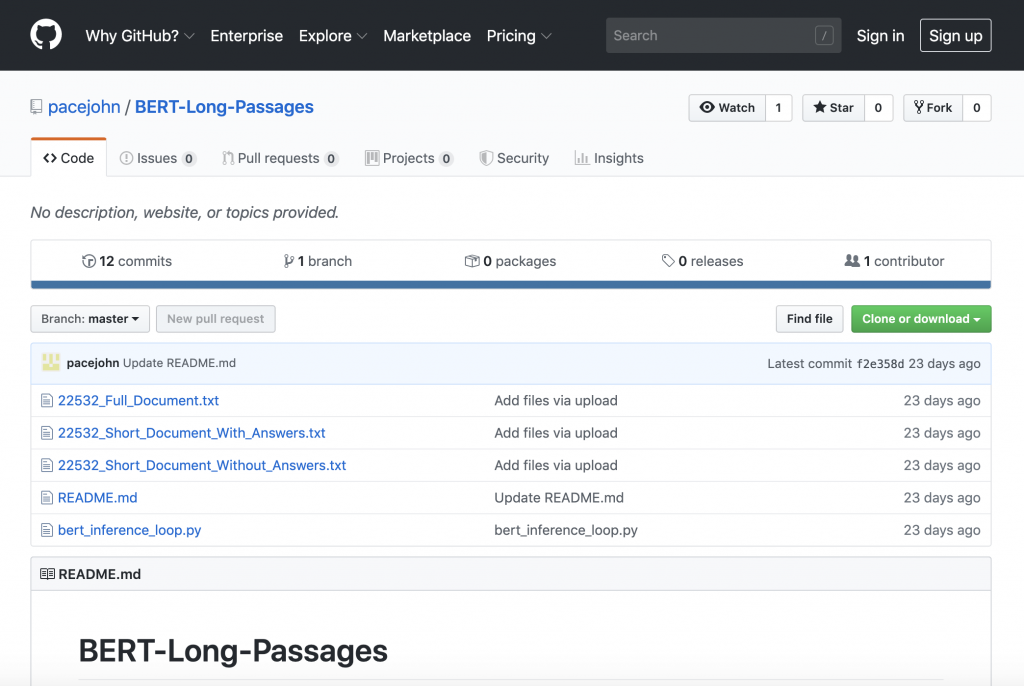Question and Answer for Long Passages Using BERT
BERT, or Bidirectional Encoder Representations from Transformers, is a new method of pre-training language representations which obtains state-of-the-art results on a wide array of Natural Language Processing (NLP) tasks. It’s safe to say it is taking the NLP world by storm. BERT was developed by Google and Nvidia has created an optimized version that uses TensorRT. (https://github.com/google-research/bert and https://devblogs.nvidia.com/nlu-with-tensorrt-bert/)
One drawback of BERT is that only short passages can be queried when performing Question & Answer. After the passages reach a certain length, the correct answer cannot be found. To run a Question & Answer query, you have to provide the passage to be queried and the question you are trying to answer from the passage.
I have created a script that allows you to query longer passages and get the correct answer. I take an input passage and break it into paragraphs that are delimited by \n. Each paragraph is then queried to try to find the answer. All answers that are returned are put into a list. The list is then analyzed to find the answer with the highest probability. This is returned as the final answer. When you run the script, you will want to change the paths to correspond with your setup. All code and files are on my GitHub HERE.
Setup
In order to run the script properly, you need to make sure that a Docker container is created. Before running the query, be sure to start the TensorRT engine. Here are the steps Nvidia says to do and that I am doing.
From home directory, run the following. It takes a while.
- Clone the TensorRT repository and navigate to BERT demo directory
- git clone --recursive https://github.com/NVIDIA/TensorRT && cd TensorRT/demo/BERT
- Create and launch the docker image
- sh python/create_docker_container.sh
- Build the plugins and download the fine-tuned models
- cd TensorRT/demo/BERT && sh python/build_examples.sh base fp16 384
- Build the TensorRT runtime engine and start it. If you don't nohup this, you won't be able to do anything else.
- nohup python python/bert_builder.py -m /workspace/models/fine-tuned/bert_tf_v2_base_fp16_384_v2/model.ckpt-8144 -o bert_base_384.engine -b 1 -s 384 -c /workspace/models/fine-tuned/bert_tf_v2_base_fp16_384_v2 > tensorrt.out &
- After you have started the engine, you can then run the Q&A query in the script
- python python/bert_inference_loop.py
- One caveat is that the TensorRT engine will terminate after a period of time. Be sure it is running before you perform you query.
Files I am using for queries
There are 3 files that can I am using as input passages. Feel free to try it with your own passages.
22532_Full_Document.txt - this is the full document I am using. If you ask a question about the first part, it will return the correct answer. If you ask a question about a later part, it will not find the answer.
22532_Short_Document_With_Answers.txt - this is a shortened passage that has answers to the query. If you use the same query as I did for the question, it will find 2 answers. The one with the higher probability is the correct answer.
22532_Short_Document_Without_Answers.txt - this is a shortened passage that does not have the answers to the query. If you use the same query as I did for the question, it will not find any answers.
The question that is asked is "How many patients experienced recurrence at 12 years of age?" Feel free to experiment.
I welcome your feedback and suggestions. Be sure to follow me on Twitter!

